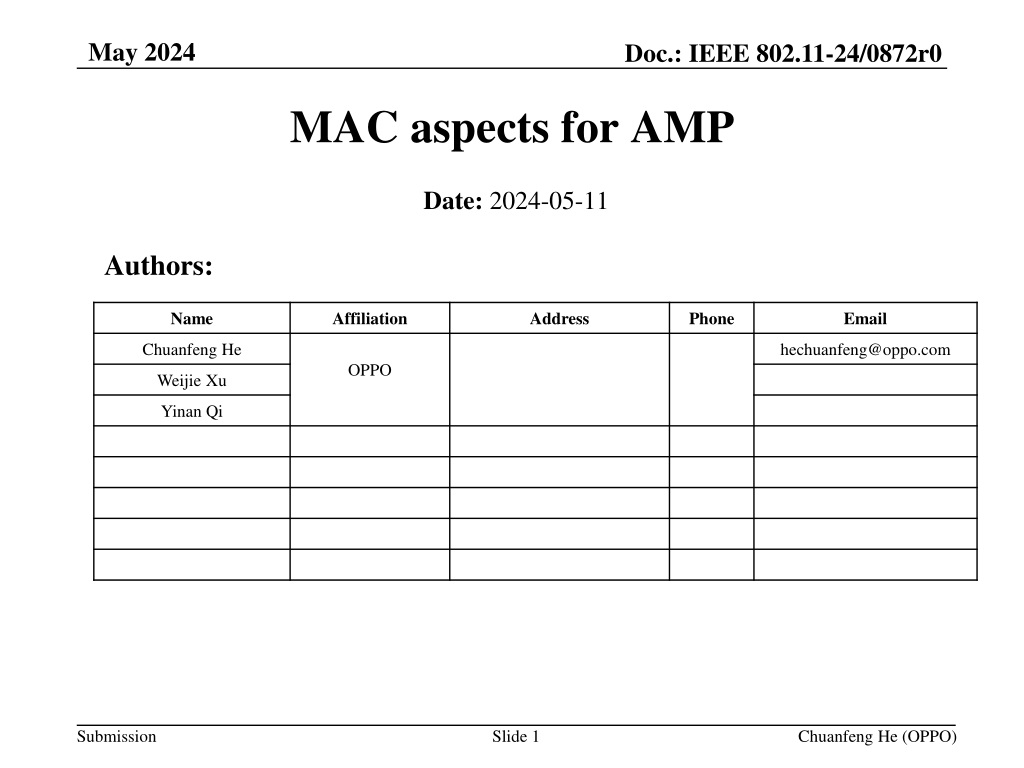

0 likes | 11 Views
This document discusses the MAC aspects for Ambient Power communication (AMP) in IEEE 802.11, focusing on frame format, channel access, synchronization, authentication, association, legacy scanning, power management, and security considerations for AMP stations. It highlights the modifications required to support AMP operation using energy harvesting.

E N D
May 2024 Doc.: IEEE 802.11-24/0872r0 MAC aspects for AMP Date: 2024-05-11 Authors: Name Affiliation Address Phone Email Chuanfeng He hechuanfeng@oppo.com OPPO Weijie Xu Yinan Qi Submission Slide 1 Chuanfeng He (OPPO)
Doc.: IEEE 802.11-24/0872r0 May 2024 Abstract • In this contribution, we discuss MAC aspects for AMP generally. Submission Slide 2 Chuanfeng He (OPPO)
May 2024 Doc.: IEEE 802.11-24/0872r0 Background • Project 802.11bp was approved by IEEE SA standards Board on 21 Mar 2024. • The TG of 802.11bp will kick off during 2024 July IEEE 802 Plenary Session. • The scope of the project is to define modifications to both the IEEE 802.11 Medium Access Control layer (MAC) and Physical Layers (PHY) to enable the operation of an Ambient Power communication (AMP) station (STA) that is powered using energy harvesting. Submission Slide 3 Chuanfeng He (OPPO)
May 2024 Doc.: IEEE 802.11-24/0872r0 Potential MAC aspects for AMP Frame format Legacy frame format includes MAC header, frame body and FCS. For AMP operation, legacy frame format can be reused with some potential optimization, e.g.: Short MAC header, e.g. short identity ofAMP STA Short management frame, e.g. Short Beacon New fields and elements are to be studied to support AMP operation, e.g. Capability of uplink transmission, backscatter or active transmission Power management related fields and elements • Submission Slide 4 Chuanfeng He (OPPO)
May 2024 Doc.: IEEE 802.11-24/0872r0 Potential MAC aspects for AMP Channel access AMP non-AP STA can not perform legacy CSMA/CA based channel access before transmission, since it can not demodulate legacy preamble and MAC header, which are modulated using OFDM. TXOP holder, such as AP, can protect the channel and allocate service periods to AMP STAs for UL transmission. At least AC_BK is defined for AMP communication access category (AC). • Submission Slide 5 Chuanfeng He (OPPO)
May 2024 Doc.: IEEE 802.11-24/0872r0 Potential MAC aspects for AMP Synchronization Short timestamp for less power consumption of AMP STA 64bits->32bits(S1G)->?bits(AMP) The time span of TSF timer for AMP STA Considering the working time is limited by power storage, TSF timer may only need to cover working time after each wake up. Periodical or triggered timestamp acquisition Power efficient timestamp Maintenance of TSF timer by periodical timestamp acquisition has a little bit more power consumption. • acquisition is needed. Submission Slide 6 Chuanfeng He (OPPO)
May 2024 Doc.: IEEE 802.11-24/0872r0 Potential MAC aspects for AMP Authentication and association Without authentication and association For inventory use case, fast label identification of the items is required. AMP STA may have no sufficient power and time to perform authentication and association. AMP STA can deliver instant UL traffic without being associated with a BSS. With authentication and association For environmental monitoring use case, the data of a sensor may be reported frequently. AMP STA can associate with a BSS by authentication and association, and deliver frequent UL traffic. The requirement of authentication and association can be use case specific. • • Submission Slide 7 Chuanfeng He (OPPO)
May 2024 Doc.: IEEE 802.11-24/0872r0 Potential MAC aspects for AMP Legacy scanning to discover a BSS Passive scanning: AMP beacon, discovery frame Active scanning: Probe request/response Power efficient scanning is needed for AMP STA, such as Use case specific scanning, e.g. passive scanning on pre- determined channels. Passive scanning assisted by discovery frame on pre-determined channels. • • Submission Slide 8 Chuanfeng He (OPPO)
May 2024 Doc.: IEEE 802.11-24/0872r0 Potential MAC aspects for AMP Power management Several power management modes have been developed in 802.11, e.g. PS-poll • Page slicing(802.11ah) TWT(802.11ah,ax) • NDP paging APSD(802.11e) PSMP(802.11n) Power management is important for AMP STA to use limited power storage to guarantee UL traffic from AMP STA . Efficient power management mode is needed for AMP operation, if legacy ones do not work well forAMP communication. • Submission Slide 9 Chuanfeng He (OPPO)
May 2024 Doc.: IEEE 802.11-24/0872r0 Potential MAC aspects for AMP Security Legacy 4-Way Handshake is required to generate and exchange key between AP and STA for security, after authentication and association procedure. It is challenging and costly for AMP STA to establish conventional secure association, with limited power and instant small volume data. For AMP communication, the establishing and maintaining secure association can be simplified, considering the procedure without authentication and association with authentication and association • Submission Slide 10 Chuanfeng He (OPPO)
May 2024 Doc.: IEEE 802.11-24/0872r0 Summary • In this submission, potential MAC issues for AMP operation are observed and generally discussed on the following aspects Frame format Channel access Synchronization Authentication and association Scanning Power management Security Submission Slide 11 Chuanfeng He (OPPO)
May 2024 Doc.: IEEE 802.11-24/0872r0 Reference 1. https://development.standards.ieee.org/myproject-web/app#viewpar/11414 Submission Slide 12 Chuanfeng He (OPPO)